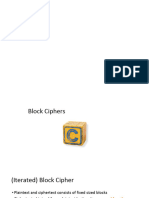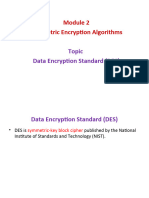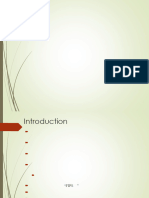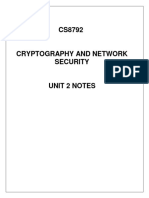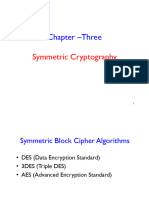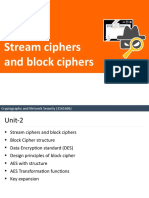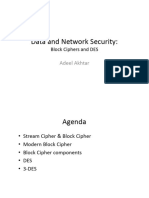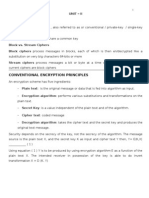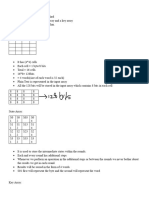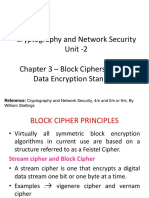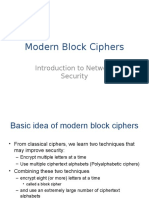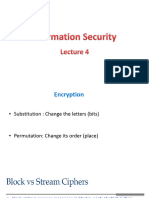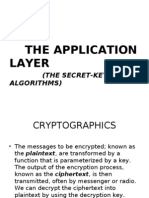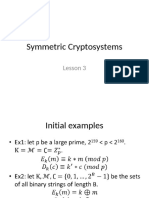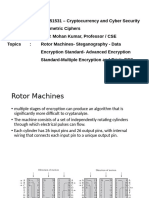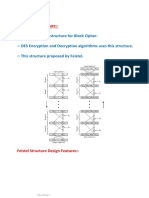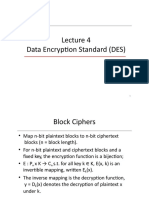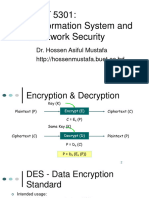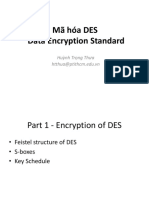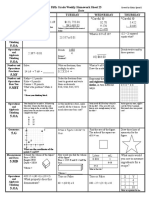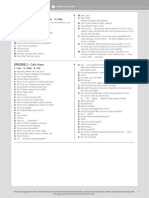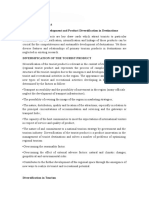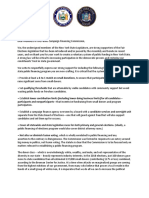0 ratings0% found this document useful (0 votes)
4 viewsLecture 5
Lecture 5
Uploaded by
hasona272002Copyright:
© All Rights Reserved
Available Formats
Download as PPTX, PDF, TXT or read online from Scribd
Lecture 5
Lecture 5
Uploaded by
hasona2720020 ratings0% found this document useful (0 votes)
4 views33 pagesCopyright
© © All Rights Reserved
Available Formats
PPTX, PDF, TXT or read online from Scribd
Share this document
Did you find this document useful?
Is this content inappropriate?
Copyright:
© All Rights Reserved
Available Formats
Download as PPTX, PDF, TXT or read online from Scribd
Download as pptx, pdf, or txt
0 ratings0% found this document useful (0 votes)
4 views33 pagesLecture 5
Lecture 5
Uploaded by
hasona272002Copyright:
© All Rights Reserved
Available Formats
Download as PPTX, PDF, TXT or read online from Scribd
Download as pptx, pdf, or txt
You are on page 1of 33
BLOCK CIPHERS
(Iterated) Block Cipher
• Plaintext and ciphertext consist of fixed-sized
blocks
• Ciphertext obtained from plaintext by iterating
a round function
• Input to round function consists of key and
output of previous round
Feistel Cipher: Encryption
• Feistel cipher is a type of block cipher is a general
cipher design principle
– Not a specific block cipher
• Split plaintext block into left and right halves: P =
(L0, R0)
• For each round i = 1, 2, ..., n, compute
Li = Ri1
Ri = Li1 F(Ri1, Ki)
where F is round function and Ki is subkey
• Ciphertext: C = (Ln, Rn)
Feistel Cipher: Encryption
Feistel Cipher: Decryption
• Start with ciphertext C = (Ln, Rn)
• For each round i = n, n1, …, 1, compute
Ri1 = Li
Li1 = Ri F(Ri1, Ki)
where F is round function and Ki is subkey
• Plaintext: P = (L0, R0)
Feistel Cipher
Data Encryption Standard (DES)
• DES is a symmetric-key block cipher published by
National Institute of Standards and Technology (NIST).
• DES is an implementation of a Feistel Cipher.
– It uses 16 round Festial structure.
– The block size is 64-bits, each Li and Ri is 32 bits.
– Though, key length is 64-bit, DES has an effective key
length of 56 bits.
– 8 of the 64 bits of the key are not used by the encryption
algorithm.
– 16 intermediary keys, each 48 bits.
Data Encryption Standard (DES)
Data Encryption Standard (DES)
Key Generation
• The bits of the key are numbered from 1 through 64.
• The keys are actually stored as being 64 bits long, but every 8th bit in the key is not used (i.e.
bits numbered 8, 16, 24, 32, 40, 48, 56, and 64). As you will see, the eight bits just mentioned
get eliminated when we create subkeys.
• The key is first subjected to Permuted Choice One
Key Generation
• The resulting 56-bit key is then treated as two 28-bit
quantities, labeled C0 and D0
• At each round, Ci-1 and Di-1 are separately subjected
to a circular left shift, or rotation, of 1 or 2 bits
Key Generation
• These shifted values serve as input to the next round.
• They also serve as input to Permuted Choice Two,
which produces a 48-bit output that serves as input
to the function F(Ri-1, Ki)
Key Generation
DES Encryption
• As with any encryption scheme, there are two
inputs to the encryption function: the
plaintext to be encrypted and the key.
DES Encryption
• The processing of the plaintext proceeds in
three phases:
1. The 64-bit plaintext passes through an initial
permutation (IP) that rearranges the bits to
produce the permuted input.
DES Encryption
2. This is followed by a phase consisting of 16
rounds of the same function, which involves both
permutation and substitution functions.
• The output of the last (sixteenth) round consists of
64 bits that are a function of the input plaintext and
the key.
• The left and right halves of the output are swapped
to produce the preoutput.
DES Encryption
3. Finally, the preoutput is passed through a permutation
() that is the inverse of the initial permutation
function, to produce the 64-bit ciphertext.
Single Round of DES Encryption
• The left and right halves of each 64-bit
intermediate value are treated as separate 32-
bit quantities, labeled L (left) and R (right).
• As in any classic Feistel cipher, the overall
processing at each round can be summarized
in the following formulas:
– Li = Ri−1
– Ri = Li−1 ⊕ F(Ri−1, Ki)
Single Round of DES Encryption
• This function F is the main part of every round
and consists of four separate stages:
1. The E-box expansion permutation: here the 32-
bit input data from Ri−1 is expanded and
permuted to give the 48 bits necessary for
combination with the 48 bit key
Single Round of DES Algorithm
Single Round of DES Encryption
2. Exclusive OR of the E-box output and 48 bit subkey Ki .
3. The S-box substitution: this is a highly important
substitution which accepts a 48-bit input and outputs a
32-bit number.
• There are 8 S-boxes (S1, S2, . . . , S8) each of which accepts
one of the 6 bit blocks.
• The output of each S-box is:
4 bit number.
S-box substitution
S-box substitution
S-box substitution
• Each of the S-boxes can be thought of as a 4 × 16 matrix.
• Each cell of the matrix is identified by a coordinate pair (i,
j), where 0 ≤ i ≤ 3 and 0 ≤ j ≤ 15.
• The value of i is taken as the decimal representation of the
first and last bits of the input to each S-box, i.e. Dec(b1b6)
= i and the value of j is take from the decimal
representation of the inner four bits that remain, i.e.
Dec(b2b3b4b5) = j.
• Each cell within the S-box matrices contains a 4-bit number
which is output once that particular cell is selected by the
input.
S-box substitution
• Example 1 The input to S-box 1 is 100011. What is
the output?
• Solution If we write the first and the sixth bits
together, we get 11 in binary, which is 3 in decimal.
• The remaining bits are 0001 in binary, which is 1 in
decimal. We look for the value in row 3, column 1,
• in (S-box 1). The result is 12 in decimal, which in
binary is 1100.
• So the input 100011 yields the output 1100.
Single Round of DES Encryption
4. The P-box permutation: This simply permutes the output
of the S-box without changing the size of the data.
• It is simply a permutation and nothing else.
DES Decryption
• As with any Feistel cipher, decryption uses the
same algorithm as encryption, except that the
order of the subkeys is reversed
DES Weak Keys
• DES has 4 weak keys (64-bit) – 01010101 01010101 –
FEFEFEFE FEFEFEFE – E0E0E0E0 F1F1F1F1 – 1F1F1F1F
0E0E0E0E
• Using weak keys, the outcome of the Permuted Choice 1 (PC1)
in the DES key schedule leads to round keys (K 1---K16) being
either all zeros, all ones or alternating zero-one patterns.
• Since all the subkeys are identical, and DES is a Feistel
network, the encryption function becomes self-inverting; that
is, encrypting twice with a weak key K produces the original
plaintext. – E K(E K(x))=x for all x, i.e., the encryption and the
decryption are the same
• Weak keys should be avoided at key generation
Double DES
Triple DES
• Use three different keys
• Encrypt: C = EK3 [ DK2 [ EK1 [P] ] ]
• Decrypt: P = DK1 [ EK2 [ DK3 [C] ]
• The standard specifies three keying options:
1) Keying option 1: All three keys are independent.
2) Keying option 2: K1 and K2 are independent, and
K3 = K1 .
3) Keying option 3: All three keys are identical, i.e.
K1 = K2 = K3 .
Triple DES (Encryption)
Triple DES
Triple DES
• Using keying option 1: the key space is 56 x 3 =
168 bits No known practical attack against it.
• Keying option 2 provides less security than
option 1, with 2 × 56 = 112 key bits. However,
this option is stronger than double DES (with
K1 and K2).
• Keying option 3 is equivalent to DES, with only
56 key bits.
You might also like
- Is - Unit 3 - Feasel CipherDocument30 pagesIs - Unit 3 - Feasel Ciphermahek malidwaleNo ratings yet
- 8 Des 18 01 2024Document22 pages8 Des 18 01 2024sankarperuriNo ratings yet
- Chapter 6 DESDocument64 pagesChapter 6 DESYaman KhalidzyNo ratings yet
- Designing Block Ciphers - DES: Dhiren PatelDocument37 pagesDesigning Block Ciphers - DES: Dhiren PatelSudha PatelNo ratings yet
- Simplified DESDocument52 pagesSimplified DESshahenaaz3No ratings yet
- Data Encryption Standard (DES)Document53 pagesData Encryption Standard (DES)resky_12No ratings yet
- DES and AES AlgorithmDocument51 pagesDES and AES Algorithmsolomon gosheNo ratings yet
- 3 - Module 2 - Symmetric-Key Ciphers 2023-Part 2Document62 pages3 - Module 2 - Symmetric-Key Ciphers 2023-Part 2ashwinmittal97No ratings yet
- Digital Encryption StandardDocument30 pagesDigital Encryption StandardManoj SunchauriNo ratings yet
- Crypto U-2Document55 pagesCrypto U-2guruvarshniganesapandiNo ratings yet
- chapter 3Document121 pageschapter 3Sara MohammedNo ratings yet
- Data Encryption StandardDocument4 pagesData Encryption StandardLionel Bharath RazerNo ratings yet
- 13 IT352 Class 14Document48 pages13 IT352 Class 14mohanNo ratings yet
- Data Encryption StandardDocument7 pagesData Encryption StandardRahul JainNo ratings yet
- CNS R-20 Unit-2Document40 pagesCNS R-20 Unit-2chayankamanjunadhareddykalliNo ratings yet
- UNIT-2 Stream Ciphers and Block Ciphers: Cryptography and Network Security (3161606)Document32 pagesUNIT-2 Stream Ciphers and Block Ciphers: Cryptography and Network Security (3161606)Ganesh GhutiyaNo ratings yet
- DesDocument31 pagesDeshelloNo ratings yet
- 3-Block Ciphers and DESDocument52 pages3-Block Ciphers and DESAbdul SammadNo ratings yet
- Unit - Ii: Information Security 1Document29 pagesUnit - Ii: Information Security 1Santhi PriyaNo ratings yet
- Aes and DesDocument11 pagesAes and Des20PCT19 THANISHKA SNo ratings yet
- Cryptography and Network Security Unit - 2 Chapter 3 - Block Ciphers and The Data Encryption StandardDocument86 pagesCryptography and Network Security Unit - 2 Chapter 3 - Block Ciphers and The Data Encryption StandardAkshit PrajapatiNo ratings yet
- January 23, 2011: C 2011 Avinash Kak, Purdue UniversityDocument32 pagesJanuary 23, 2011: C 2011 Avinash Kak, Purdue Universitymoon_manNo ratings yet
- DesDocument19 pagesDesmanju287No ratings yet
- CNS Unit 2Document119 pagesCNS Unit 2Mr.Ashok SNo ratings yet
- Ch3 Block Ciphers and DES - BlackboardDocument37 pagesCh3 Block Ciphers and DES - BlackboardYazanAlomariNo ratings yet
- Lecture4 Information Security - 230108 - 235829Document26 pagesLecture4 Information Security - 230108 - 235829tedsNo ratings yet
- Cns Des, SdesDocument78 pagesCns Des, SdesshriyaranjithvNo ratings yet
- Des & Aes: 19CSE311 Computer Security Jevitha KP Department of CSEDocument49 pagesDes & Aes: 19CSE311 Computer Security Jevitha KP Department of CSEugiyuNo ratings yet
- Data Encryption StandardDocument44 pagesData Encryption StandardAnkur AgrawalNo ratings yet
- Week04 DesDocument52 pagesWeek04 DesAftab AhmedNo ratings yet
- Data Encryption Standard (DES)Document6 pagesData Encryption Standard (DES)Faraz BestNo ratings yet
- The Application Layer: Algorithms)Document19 pagesThe Application Layer: Algorithms)VinayKumarSinghNo ratings yet
- DBS Lecture3Document11 pagesDBS Lecture3Trần QiNo ratings yet
- Is DesDocument53 pagesIs Desbcsm-s21-005No ratings yet
- NTC Project ReportDocument7 pagesNTC Project ReportDhivya KarthikeyanNo ratings yet
- Cys535 Lecture03Document70 pagesCys535 Lecture03Waseem LaghariNo ratings yet
- DesDocument31 pagesDesmohan kumarNo ratings yet
- This Is The Basis Structure For Block Cipher. DES Encryption and Decryption Algorithms Uses This Structure. This Structure Proposed by FeistelDocument12 pagesThis Is The Basis Structure For Block Cipher. DES Encryption and Decryption Algorithms Uses This Structure. This Structure Proposed by FeistelNaga sai ChallaNo ratings yet
- Cryptography-Symmetric - Modern - DeCDocument41 pagesCryptography-Symmetric - Modern - DeCLam CaoNo ratings yet
- Block Cipher 9 Oct, PPTDocument40 pagesBlock Cipher 9 Oct, PPTdeecodes13No ratings yet
- Number Theory & CryptographyDocument18 pagesNumber Theory & CryptographyPrateek ParashariNo ratings yet
- C3-Cryptography Block Cipher and Modes of OperationsDocument29 pagesC3-Cryptography Block Cipher and Modes of OperationsTrần HiếuNo ratings yet
- Ch4. Cryptography - Diffie Hellman Key Exchange 1Document34 pagesCh4. Cryptography - Diffie Hellman Key Exchange 1عبسي ابو محمدNo ratings yet
- DesDocument58 pagesDesHarneet Singh ChuggaNo ratings yet
- Secret Key CryptographyDocument32 pagesSecret Key Cryptographyvidhya_bineeshNo ratings yet
- Chapter 3 in StallingsDocument65 pagesChapter 3 in Stallingsgopal_svsemails8998No ratings yet
- L15_L18Document25 pagesL15_L18junaidakhtar.eccNo ratings yet
- Modern Block Ciphers: CSE 651: Introduction To Network SecurityDocument52 pagesModern Block Ciphers: CSE 651: Introduction To Network SecurityVinothsaravanan RamakrishnanNo ratings yet
- Data Encryption Standard (DES)Document52 pagesData Encryption Standard (DES)asmita dagadeNo ratings yet
- Assignment 1_Neeraj Mukesh Jawahirani(nj23b)-1Document5 pagesAssignment 1_Neeraj Mukesh Jawahirani(nj23b)-1Engineering StudiesNo ratings yet
- Week 3 - DES PDFDocument31 pagesWeek 3 - DES PDFM NNo ratings yet
- 3. Data Encryption Standard (DES)Document21 pages3. Data Encryption Standard (DES)singhlegend382No ratings yet
- CNS Unit-IiDocument36 pagesCNS Unit-IiGanesh Pavan Kumar BattulaNo ratings yet
- DES SlideDocument34 pagesDES SlideInshal AyazNo ratings yet
- ICT 5301 Lecture3Document36 pagesICT 5301 Lecture3voccubdNo ratings yet
- ch03 3 PDFDocument31 pagesch03 3 PDFHoàng HảiNo ratings yet
- 2-2 DesDocument19 pages2-2 DesvishalyogaNo ratings yet
- CNS Unit 2Document38 pagesCNS Unit 2LOGESH WARAN PNo ratings yet
- Lecture 1 - ICT DocumentsDocument28 pagesLecture 1 - ICT DocumentsJohannes ManezNo ratings yet
- Computer System Expansion SlotsDocument5 pagesComputer System Expansion SlotsMary Millare100% (1)
- 3 13 17weekly Homework Sheet Week 25 - 5th Grade - CcssDocument2 pages3 13 17weekly Homework Sheet Week 25 - 5th Grade - Ccssapi-328344919No ratings yet
- Topic 2 - How an Aeroplane Flies MSCDocument23 pagesTopic 2 - How an Aeroplane Flies MSCSIMRAN SAHOONo ratings yet
- ALH Level1 CafeHub VideoscriptsDocument6 pagesALH Level1 CafeHub VideoscriptsNguyễn HàoNo ratings yet
- Deplatforming Websci2021Document9 pagesDeplatforming Websci2021RatkoMRNo ratings yet
- 6129-204 Cold Water Systems Version ADocument17 pages6129-204 Cold Water Systems Version AP_DaviesNo ratings yet
- Namma Kalvi 12th Bio-zoology Unit v Surya Biology Guide EmDocument68 pagesNamma Kalvi 12th Bio-zoology Unit v Surya Biology Guide EmdheebansoundarNo ratings yet
- Backyardigans - Pesquisa GoogleDocument1 pageBackyardigans - Pesquisa Googlepaulocampero999No ratings yet
- Sanborn Response WilliamsonDocument8 pagesSanborn Response WilliamsonAnonymous HtDbszqtNo ratings yet
- Answer For The Workshop On Fertilizer Recommendation ComputationDocument10 pagesAnswer For The Workshop On Fertilizer Recommendation ComputationPca ZdnNo ratings yet
- Tourism Product DevelopmentDocument4 pagesTourism Product DevelopmentK GreyNo ratings yet
- BullyingDocument15 pagesBullyingRose Ann AlerNo ratings yet
- Cambridge Assessment International Education: Business Studies 0450/11 October/November 2018Document15 pagesCambridge Assessment International Education: Business Studies 0450/11 October/November 2018Hyacinth ChimundaNo ratings yet
- 2.business Studies - MsDocument6 pages2.business Studies - Mscommerce12onlineclassesNo ratings yet
- Ged 105Document3 pagesGed 105Reymond AdayaNo ratings yet
- An Evaluation of The Trust System of BangladeshDocument15 pagesAn Evaluation of The Trust System of BangladeshNur Un NaharNo ratings yet
- Script SPP 204 BDocument4 pagesScript SPP 204 BharubisenpaiNo ratings yet
- CAB v. Delta Air Lines, Inc., 367 U.S. 316 (1961)Document24 pagesCAB v. Delta Air Lines, Inc., 367 U.S. 316 (1961)Scribd Government DocsNo ratings yet
- Vienna, Austria - Amsterdam, Netherlands 6 Days. (Vienna 3 Days and Amsterdam 3 Days)Document16 pagesVienna, Austria - Amsterdam, Netherlands 6 Days. (Vienna 3 Days and Amsterdam 3 Days)Yenifer Quiroga HerreraNo ratings yet
- Mechanistic Empirical - PPT Compatibility MDocument33 pagesMechanistic Empirical - PPT Compatibility MKhin Khin ThawNo ratings yet
- 22025Document27 pages22025dvkhedaryNo ratings yet
- Punjab Assembly 2013Document36 pagesPunjab Assembly 2013asadaliNo ratings yet
- Fair Elections Letter PDFDocument3 pagesFair Elections Letter PDFChris BraggNo ratings yet
- Department of Education: Schools Division of Puerto Princesa CityDocument5 pagesDepartment of Education: Schools Division of Puerto Princesa Cityjinky p.paloma100% (1)
- FWD 41077Document33 pagesFWD 41077adrian joseNo ratings yet
- Introduction To The Philosophy of Human Person Module 6-Week 6Document8 pagesIntroduction To The Philosophy of Human Person Module 6-Week 6Mariel Lopez - Madrideo100% (1)
- Alexa Loses Her VoiceDocument5 pagesAlexa Loses Her Voiceapi-462289983100% (2)
- Exercise COPD-342-355 SeparadoDocument14 pagesExercise COPD-342-355 SeparadoKuririn matiasNo ratings yet
- Smoke Social Media Infographics by SlidesgoDocument35 pagesSmoke Social Media Infographics by SlidesgoAvinash RishiNo ratings yet
